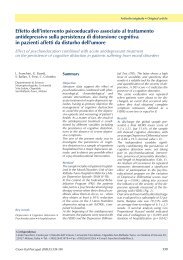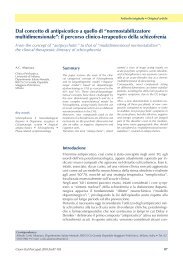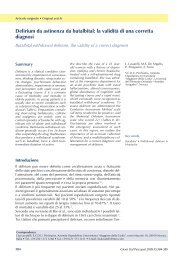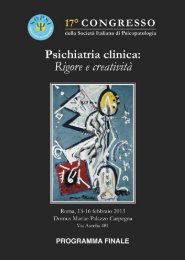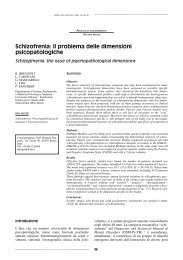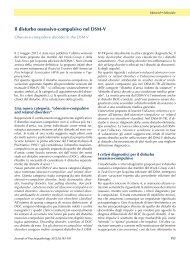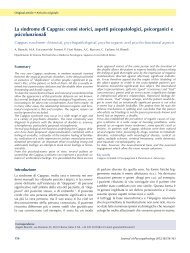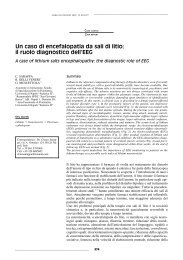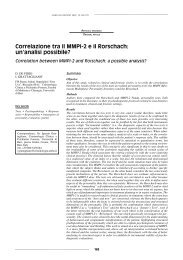XI Congresso della Società Italiana di Psicopatologia Psichiatria ...
XI Congresso della Società Italiana di Psicopatologia Psichiatria ...
XI Congresso della Società Italiana di Psicopatologia Psichiatria ...
Create successful ePaper yourself
Turn your PDF publications into a flip-book with our unique Google optimized e-Paper software.
SESSIONI PLENARIE<br />
SABATO 25 FEBBRAIO - ORE 10.15-12.00<br />
SALA CAVALIERI 1<br />
Sessione Plenaria - Nuove frontiere terapeutiche<br />
Tecniche neurochirurgiche emergenti<br />
per il trattamento dei <strong>di</strong>sturbi psichiatrici<br />
farmaco-resistenti<br />
P. Romanelli<br />
Neurochirurgia Funzionale, Neuromed IRCCS, Pozzilli;<br />
Clinical Assistant Professor, Department of Neurology,<br />
State University of New York<br />
L’introduzione <strong>di</strong> tecniche <strong>di</strong> stimolazione cerebrale<br />
profonda nel trattamento <strong>di</strong> <strong>di</strong>sturbi del movimento come<br />
il morbo <strong>di</strong> Parkinson ha <strong>di</strong>mostrato la possibilità <strong>di</strong> trattare<br />
<strong>di</strong>sturbi funzionali del sistema nervoso centrale in<br />
modo efficace, adattabile al singolo paziente, reversibile<br />
e con limitata morbi<strong>di</strong>tà. Altre tecniche <strong>di</strong> neurostimolazione<br />
come la stimolazione del nervo vago hanno provato<br />
la loro efficacia nel trattamento dell’epilessia farmacorefrattaria.<br />
Sia la stimolazione cerebrale profonda che la<br />
stimolazione vagale sono state utilizzate in pazienti con<br />
depressione severa e resistente alla terapia me<strong>di</strong>ca. Più in<br />
particolare, la stimolazione con elettro<strong>di</strong> profon<strong>di</strong> del giro<br />
del cingolo sub-genuale ha <strong>di</strong>mostrato una notevole efficacia<br />
nel risolvere casi severi <strong>di</strong> depressione farmacorefrattaria.<br />
La stimolazione del nervo vago è stata a sua volta<br />
applicata al trattamento <strong>di</strong> casi <strong>di</strong> depressione farmacorefrattaria,<br />
mostrando una crescente efficacia col passare<br />
dei mesi. Dal punto <strong>di</strong> vista chirurgico, la stimolazione<br />
del nervo vago richiede l’esposizione del fascio vascolonervoso<br />
del collo, costituito da arteria carotide e vena giugulare,<br />
con il nervo vago posto tra le due. La stimolazione<br />
cerebrale profonda richiede l’impianto <strong>di</strong> un casco stereotassico<br />
e viene eseguito tramite l’impianto <strong>di</strong> un elettrodo<br />
<strong>di</strong> profon<strong>di</strong>tà attraverso un foro <strong>di</strong> trapano. In entrambi<br />
I casi l’elettrodo stimolante viene collegato tramite<br />
un cavo d’estensione alla batteria, che viene impiantata<br />
in sede toracica subclaveare. La durata <strong>della</strong> batteria<br />
varia <strong>di</strong>a 3 ai 5 anni. La possibilità <strong>di</strong> offrire un trattamento<br />
chirurgico efficace, reversibile, <strong>di</strong> modesta invasività<br />
e con limitati effetti collaterali e complicanze può<br />
rappresentare un’utilissima aggiunta all’armamentario terapeutico<br />
psichiatrico, offrendo la possibilità <strong>di</strong> modulare<br />
in maniera selettiva specifici circuiti neuropsichiatrici riequilibrandone<br />
la funzione. La selezione dei pazienti can<strong>di</strong>dabili<br />
all’intervento come pure la loro gestione postchirurgica<br />
rimane completamente nelle mani dello psichiatra,<br />
che costituisce la figura <strong>di</strong> riferimento <strong>di</strong> un team<br />
comprendente neurochirurgo funzionale e neuropsicologo.<br />
L’approccio integrato me<strong>di</strong>co-chirurgico, che ha già<br />
prodotto notevolissimi risultati nella terapia del morbo <strong>di</strong><br />
Parkinson, può rappresentare un notevole passo avanti rispetto<br />
ai correnti para<strong>di</strong>gmi <strong>di</strong> trattamento delle malattie<br />
neuropsichiatriche ed aprire la strada allo sviluppo <strong>di</strong><br />
nuove conoscenze sull’interazione tra mente e cervello.<br />
MODERATORI<br />
G. Cantore (Pozzilli), P. Pancheri (Roma)<br />
Applications of repetitive transcranial<br />
magnetic stimulation (rTMS) to therapy<br />
in psychiatry<br />
A. Mantovani<br />
Department of Neuroscience, Division of Brain Stimulation<br />
and Neuromodulation, New York State Psychiatric Institute,<br />
Columbia University, New York; Department of Neuroscience,<br />
Division of Psychiatry, Division of Neurophysiology,<br />
Postgraduate School in Applied Neurological Sciences,<br />
Siena University<br />
Repetitive transcranial magnetic stimulation (rTMS) has<br />
been applied in a growing number of psychiatric <strong>di</strong>sorders<br />
as a putative treatment. rTMS is unparalleled in its ability<br />
to test the hypotheses generated by functional neuroimaging<br />
stu<strong>di</strong>es by focally modulating activity in selected neural<br />
circuits. As a focal intervention that may in some cases<br />
exert lasting effects, rTMS offers the hope of targeting and<br />
ameliorating the circuitry underlying psychiatric <strong>di</strong>sorders.<br />
The ultimate success of such an approach depends upon<br />
our knowledge of the neural circuitry underlying these <strong>di</strong>sorders,<br />
on how rTMS exerts its effects, and on how to control<br />
the application of rTMS to exert the desired effects.<br />
While most clinical trials have focused on the treatment of<br />
major depression, increasing attention has been paid to<br />
schizophrenia and anxiety <strong>di</strong>sorders. Many of these trials<br />
have supported a significant effect of rTMS, but in some<br />
stu<strong>di</strong>es the effect is small and short-lived. Current challenges<br />
in the field include determining how to enhance the<br />
efficacy of rTMS in these <strong>di</strong>sorders, and how to identify<br />
patients for whom rTMS may be efficacious.<br />
Problematiche psichiatrico forensi<br />
dei trattamenti chirurgici per <strong>di</strong>sturbi<br />
psichiatrici<br />
S. Ferracuti<br />
Dipartimento <strong>di</strong> Scienze Psichiatriche e Me<strong>di</strong>cina Psicologica,<br />
Università <strong>di</strong> Roma «La Sapienza»<br />
Il rinnovato interesse e la <strong>di</strong>ffusione <strong>di</strong> <strong>di</strong>verse nuove tecniche<br />
neurochirurgiche per il trattamento dei <strong>di</strong>sturbi psichiatrici<br />
ripropone in termini contemporanei il problema<br />
del consenso a terapie chirurgiche che comportino mo<strong>di</strong>ficazioni<br />
funzionali del Sistema Nervoso Centrale.<br />
Il neurochirurgo portoghese Moniz propose nel 1936 l’intervento<br />
<strong>di</strong> leucotomia prefrontale che ebbe in seguito ampia<br />
<strong>di</strong>ffusione, specialmente nel trattamento <strong>della</strong> schizofrenia,<br />
con oltre 40.000 interventi <strong>di</strong> lobotomia prefrontale<br />
eseguiti fino alla seconda metà degli anni’50, <strong>di</strong> cui oltre la<br />
metà negli Stati Uniti. I risultati dell’applicazione in<strong>di</strong>scriminata<br />
<strong>della</strong> tecnica, in un contesto <strong>di</strong> stu<strong>di</strong> non controlla-<br />
14




